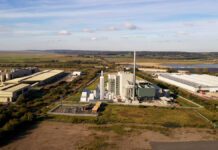Mikael Khan of environmental consultancy Aqua Enviro, offers a few thoughts on maximising AD plant efficiency and revenues by interrogating mixing performance in reactor tanks.

Reactor vessels, whether they be anaerobic digesters (AD) or other water treatment reactor tanks, tend to deviate from ideal mixing conditions over time. This can have a huge impact on plant performance and can result in reduced revenues to catastrophic failure of complete systems.
Focusing specifically on AD reactors, a lack of mixing efficiency is the most immediate indicator of potential issues with an AD system and can be used as a metric to interrogate plant performance against contractual requirements during commissioning or at regular intervals during plant operations.
Grit gripes
Factors such as gradual grit deposition in the reactor tanks can lead to reduced active volume, dead zones and short circuiting which can all have a direct impact on plant performance, safety, ability to comply with permits and revenue generation. When left unmonitored, grit accumulation can account for active volume reductions of up to 8-10% per annum, resulting in a rapid drop off in plant performance and energy output.
Operators can choose from methods going from rudimentary thermal imaging, to dyes, to more comprehensive tracer testing to interrogate the mixing efficiencies and active volume of their reactor vessels. While thermal imaging is a quick test to highlight issues, it struggles to provide a complete and accurate assessment especially in the case of insulated tanks.
Tracer testing, on the other hand (see below), while being more resource intensive than the former, provides a detailed mixing efficiency profile of the reactor vessels. Performed at regular intervals the tracer tests provide valuable insight and can help operators take proactive, informed decisions to maximize revenues, prevent major failure events and keep within permits.
The question is: how widespread is the use of regular tracer testing across the AD industry in particular, as part of preventative maintenance and not reactive maintenance? While restricted operational and plant maintenance budgets may be a barrier to frequent testing and preventative maintenance, the benefits of a regular testing programme arguably outweigh the testing costs by enhancing plant efficiency and revenue generation from biogas production as well as enhancing safety and avoiding fines for out of compliance site permits, or complete plant failure.
Scheduled tracer testing needs to be part of preventative maintenance and asset optimization schemes as it is a key element of resilience strategies.
What is a tracer test?
Tracer tests are performed by introducing a tracer which can be a dye, radioactive compound or a salt solution into the inlet of a reactor, followed by measuring the concentration of the tracer in the effluent at regular intervals. The difference in concentration profile for an ideal mix condition to that experimentally determined provides an insight into active volume, dead zones and short circuiting within the reactor / tank.
The most common tracers used in the industry are lithium chloride and fluoride compounds. Lithium chloride is generally the tracer of choice as it is safe to human health at the concentrations of use, and safe to handle and transport. It also has high solubility in water. Lithium being much more stable than fluoride, also has the added advantage of not interacting or being consumed by the process it is interrogating.







